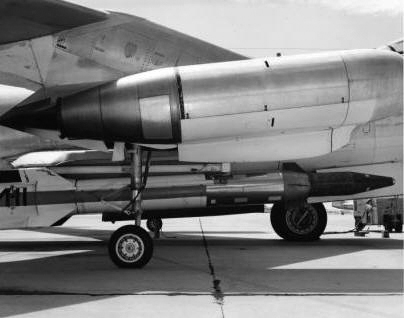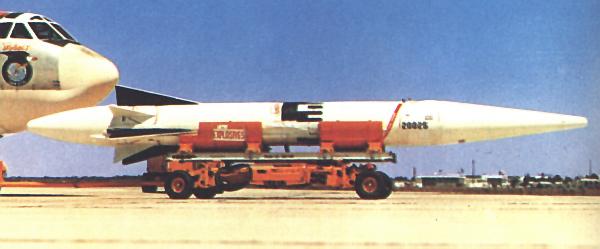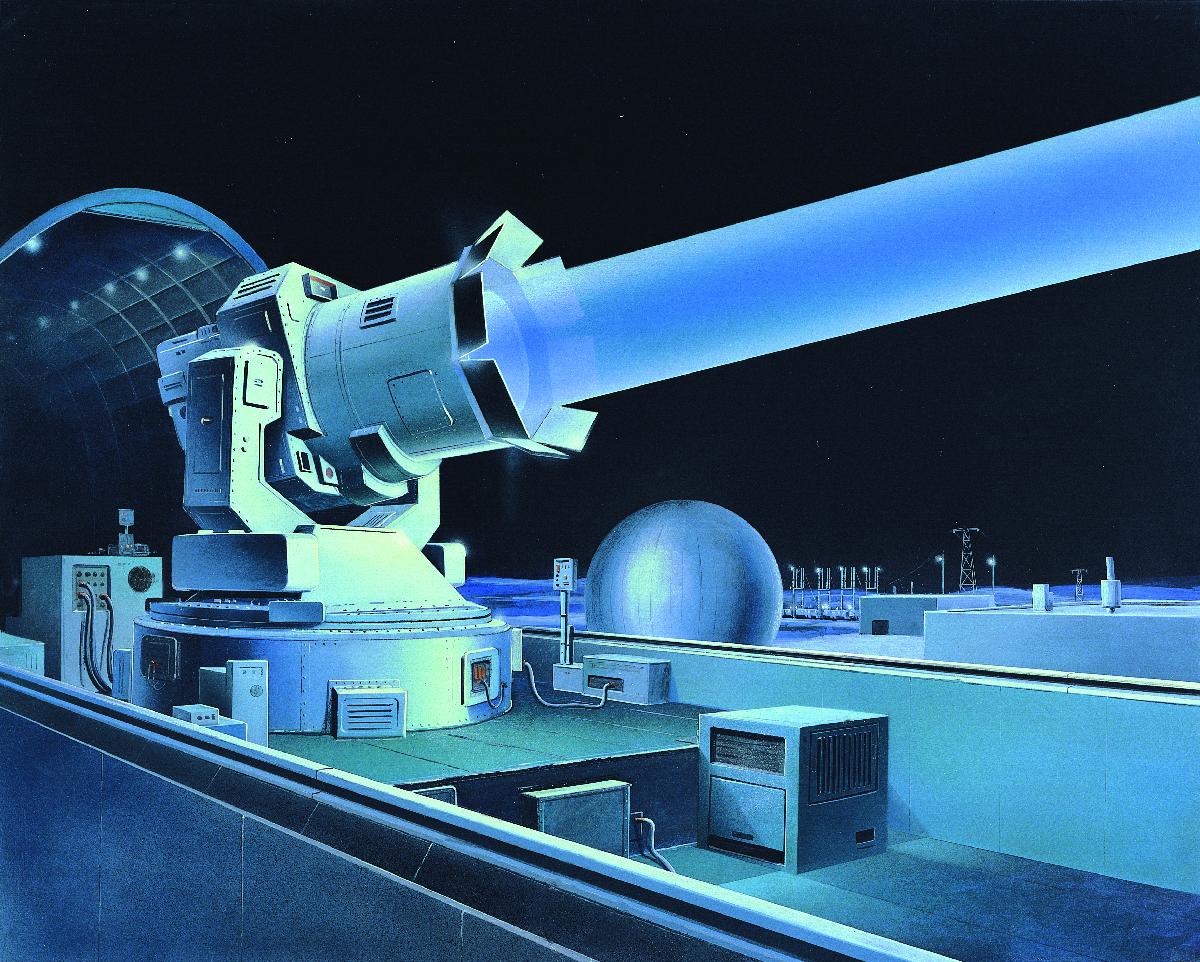|
Bold Orion
The Bold Orion missile, also known as Weapons System 199B (WS-199B), was a prototype air-launched ballistic missile (ALBM) developed by Martin Aircraft during the 1950s. Developed in both one- and two-stage designs, the missile was moderately successful in testing, and helped pave the way for development of the GAM-87 Skybolt ALBM. In addition, the Bold Orion was used in early anti-satellite weapons testing, performing the first interception of a satellite by a missile. Design and development The Bold Orion missile was developed as part of Weapons System 199, initiated by the United States Air Force (USAF) in response to the U.S. Navy's Polaris program, with funding authorised by the United States Congress in 1957.Yengst 2010, p.37. The purpose of WS-199 was the development of technology that would be used in new strategic weapons for the USAF's Strategic Air Command, not to deliver operational weapons; a primary emphasis was on proving the feasibility of an air-launched ballist ... [...More Info...] [...Related Items...] OR: [Wikipedia] [Google] [Baidu] |
Air-launched Ballistic Missile
An air-launched ballistic missile or ALBM is a ballistic missile launched from an aircraft. An ALBM allows the launch aircraft to stand off at long distances from its target, keeping it well outside the range of defensive weapons like anti-aircraft missiles and interceptor aircraft. Historically, once launched the missile was essentially immune to interception due to a lack of capable anti-ballistic missiles, with those few that did exist being limited to known static positions. This combination of features allowed a strategic bomber to present a credible deterrent second-strike option in an era when improving anti-aircraft defences appeared to be rendering conventional bombers obsolete. However, by the 1990's surface-to-air missile technology had innovated to the point of allowing the interception of such weapons (especially in their terminal phase) from road mobile systems, albeit at a lower PoK. By the early 21st century capable, dedicated, ABM systems from several nations had b ... [...More Info...] [...Related Items...] OR: [Wikipedia] [Google] [Baidu] |
Boeing B-47 Stratojet
The Boeing B-47 Stratojet (Boeing company designation Model 450) is a retired American long-range, six-engined, turbojet-powered strategic bomber designed to fly at high subsonic speed and at high altitude to avoid enemy interceptor aircraft. The primary mission of the B-47 was as a nuclear bomber capable of striking targets within the Soviet Union. Development of the B-47 can be traced back to a requirement expressed by the United States Army Air Forces (USAAF) in 1943 for a reconnaissance bomber that harnessed newly developed jet propulsion. Another key innovation adopted during the development process was the swept wing, drawing upon captured German research. With its engines carried in nacelles underneath the wing, the B-47 represented a major innovation in post-World War II combat jet design, and contributed to the development of modern jet airliners. Suitably impressed, in April 1946, the USAAF ordered two prototypes, designated "XB-47"; on 17 December 1947, the first ... [...More Info...] [...Related Items...] OR: [Wikipedia] [Google] [Baidu] |
Alpha Draco
The Alpha Draco missile, also known as Weapons System 199D (WS-199D), was an experimental ballistic missile developed by McDonnell Aircraft in the late 1950s to investigate the aerodynamic physics of the boost-glide reentry trajectory. Three test flights were conducted in 1959, of which two were successful. Design and development As part of the WS-199 project to develop new strategic weapons for the United States Air Force's Strategic Air Command, McDonnell Aircraft developed the Alpha Draco missile between 1957 and 1959, under a contract to launch three vehicles to determine the feasibility of the boost-glide reentry vehicle (BGRV) concept.Brulle 2008, p. 89. The purpose of the rocket was to establish whether a strategic missile using the "boost-glide" principle of propulsion could be practically used.Parsch 2005. The idea had been proposed by Walter Dornberger, who had moved to McDonnell after working for a short time at Bell Aircraft. Dornberger had originally worked on the i ... [...More Info...] [...Related Items...] OR: [Wikipedia] [Google] [Baidu] |
Terra-3
Terra-3 (Russian language, Russian: терра–3) was a Soviet laser testing centre, located on the Sary Shagan anti-ballistic missile (ABM) testing range in the Karaganda Region of Kazakhstan. It was originally built to test missile defense concepts, but these attempts were dropped after the Anti-Ballistic Missile Treaty was signed. The site later hosted two modest devices used primarily for experiments in space tracking. Several other laser test sites were also active during this period. During the 1980s, officials within the United States Department of Defense (DoD) suggested it was the site of a prototypical anti-satellite weapon system."Soviets could have laser able to blind US satellites" ''Gadsden Times'', 10 April 1984 The ... [...More Info...] [...Related Items...] OR: [Wikipedia] [Google] [Baidu] |
AMR DZ
The Eastern Range (ER) is an American rocket range (Spaceport) that supports missile and rocket launches from the two major launch heads located at Cape Canaveral Space Force Station and the Kennedy Space Center (KSC), Florida. The range has also supported Ariane launches from the Guiana Space Centre as well as launches from the Wallops Flight Facility and other lead ranges. The range also uses instrumentation operated by NASA at Wallops and KSC. The range can support launches between 37° and 114° azimuth. The headquarters of the range is now the 45th Space Wing at Patrick Space Force Base. History The history of the Eastern Range began on 18 October 1940, with the activation of the Banana River Naval Air Station which supported antisubmarine sea-patrol planes during World War II. The station was deactivated and put into a caretaker status on 1 September 1947. Launches of captured German V-2 rockets had been ongoing since the end of World War II at White Sands P ... [...More Info...] [...Related Items...] OR: [Wikipedia] [Google] [Baidu] |
Apogee
An apsis (; ) is the farthest or nearest point in the orbit of a planetary body about its primary body. For example, the apsides of the Earth are called the aphelion and perihelion. General description There are two apsides in any elliptic orbit. The name for each apsis is created from the prefixes ''ap-'', ''apo-'' (), or ''peri-'' (), each referring to the farthest and closest point to the primary body the affixing necessary suffix that describes the primary body in the orbit. In this case, the suffix for Earth is ''-gee'', so the apsides' names are ''apogee'' and ''perigee''. For the Sun, its suffix is ''-helion'', so the names are ''aphelion'' and ''perihelion''. According to Newton's laws of motion, all periodic orbits are ellipses. The barycenter of the two bodies may lie well within the bigger body—e.g., the Earth–Moon barycenter is about 75% of the way from Earth's center to its surface. If, compared to the larger mass, the smaller mass is negligible (e.g., f ... [...More Info...] [...Related Items...] OR: [Wikipedia] [Google] [Baidu] |
Cape Canaveral
, image = cape canaveral.jpg , image_size = 300 , caption = View of Cape Canaveral from space in 1991 , map = Florida#USA , map_width = 300 , type =Cape , map_caption = Location in Florida , location = Florida, United States , water_bodies = Atlantic Ocean , coordinates = , relief = 1 , elevation = , area = , references = Cape Canaveral ( es, Cabo Cañaveral) is a cape in Brevard County, Florida, in the United States, near the center of the state's Atlantic coast. Officially Cape Kennedy from 1963 to 1973, it lies east of Merritt Island, separated from it by the Banana River. It is part of a region known as the Space Coast, and is the site of the Cape Canaveral Space Force Station. Since many U.S. spacecraft have been launched from both the station and the Kennedy Space Center on adjacent Merritt Island, the two are sometimes conflated with each other. Other features of the cape include Port Canavera ... [...More Info...] [...Related Items...] OR: [Wikipedia] [Google] [Baidu] |
Bold Orion On B-47
In typography, emphasis is the strengthening of words in a text with a font in a different style from the rest of the text, to highlight them. It is the equivalent of prosody stress in speech. Methods and use The most common methods in Western typography fall under the general technique of emphasis through a change or modification of font: ''italics'', boldface and . Other methods include the alteration of LETTER CASE and as well as and *additional graphic marks*. Font styles and variants The human eye is very receptive to differences in "brightness within a text body." Therefore, one can differentiate between types of emphasis according to whether the emphasis changes the " blackness" of text, sometimes referred to as typographic color. A means of emphasis that does not have much effect on blackness is the use of ''italics'', where the text is written in a script style, or ''oblique'', where the vertical orientation of each letter of the text is slanted to the left ... [...More Info...] [...Related Items...] OR: [Wikipedia] [Google] [Baidu] |
International Aeronautic Federation
International is an adjective (also used as a noun) meaning "between nations". International may also refer to: Music Albums * ''International'' (Kevin Michael album), 2011 * ''International'' (New Order album), 2002 * ''International'' (The Three Degrees album), 1975 *''International'', 2018 album by L'Algérino Songs * The Internationale, the left-wing anthem * "International" (Chase & Status song), 2014 * "International", by Adventures in Stereo from ''Monomania'', 2000 * "International", by Brass Construction from ''Renegades'', 1984 * "International", by Thomas Leer from ''The Scale of Ten'', 1985 * "International", by Kevin Michael from ''International'' (Kevin Michael album), 2011 * "International", by McGuinness Flint from ''McGuinness Flint'', 1970 * "International", by Orchestral Manoeuvres in the Dark from '' Dazzle Ships'', 1983 * "International (Serious)", by Estelle from '' All of Me'', 2012 Politics * Political international, any transnational organization of ... [...More Info...] [...Related Items...] OR: [Wikipedia] [Google] [Baidu] |
Eisenhower Administration
Dwight D. Eisenhower's tenure as the 34th president of the United States began with his first inauguration on January 20, 1953, and ended on January 20, 1961. Eisenhower, a Republican from Kansas, took office following a landslide victory over Democrat Adlai Stevenson in the 1952 presidential election. John F. Kennedy succeeded him after winning the 1960 presidential election. Eisenhower held office during the Cold War, a period of geopolitical tension between the United States and the Soviet Union. Eisenhower's New Look policy stressed the importance of nuclear weapons as a deterrent to military threats, and the United States built up a stockpile of nuclear weapons and nuclear weapons delivery systems during Eisenhower's presidency. Soon after taking office, Eisenhower negotiated an end to the Korean War, resulting in the partition of Korea. Following the Suez Crisis, Eisenhower promulgated the Eisenhower Doctrine, strengthening U.S. commitments in the Middle East. In re ... [...More Info...] [...Related Items...] OR: [Wikipedia] [Google] [Baidu] |
High Virgo
The High Virgo, also known as Weapons System 199C (WS-199C), was a prototype air-launched ballistic missile (ALBM) jointly developed by Lockheed and the Convair division of General Dynamics during the late 1950s. The missile proved moderately successful and aided in the development of the later GAM-87 Skybolt ALBM. It was also used in early tests of anti-satellite weapons. Design and development As part of the WS-199 project to develop new strategic weapons for the United States Air Force's Strategic Air Command, the Lockheed Corporation and the Convair division of General Dynamics proposed the development of an air-launched ballistic missile, to be carried by the Convair B-58 Hustler supersonic medium bomber.Parsch 2005 In early 1958 the two companies were awarded a contract for development of the weapon, designated WS-199C and given the code-name "High Virgo". While the project was intended to be strictly a research-and-development exercise, it was planned that the weapon woul ... [...More Info...] [...Related Items...] OR: [Wikipedia] [Google] [Baidu] |
Explorer 6
Explorer 6, or S-2, was a NASA satellite, launched on 7 August 1959, at 14:24:20 GMT. It was a small, spheroidal satellite designed to study trapped radiation of various energies, galactic cosmic rays, geomagnetism, radio propagation in the upper atmosphere, and the flux of micrometeorites. It also tested a scanning device designed for photographing the Earth's cloud cover. On 14 August 1959, Explorer 6 took the first photos of Earth from a satellite. Experiments Beacon (108 and 378 MHz) This experiment measured the electron density near the satellite. The observational equipment comprised two coherent transmitters operating at 108 and 378 MHz. Doppler difference frequency and change in Faraday rotation of the 108-MHz signal were observed. Signals were observed from the receiving station at Hawaii for 20 to 70 minutes during each of eight passes during 11 days. Severe fading and a strong magnetic storm added to difficulties in data interpretation. The 378-MHz beacon tr ... [...More Info...] [...Related Items...] OR: [Wikipedia] [Google] [Baidu] |




.png)

.png)

